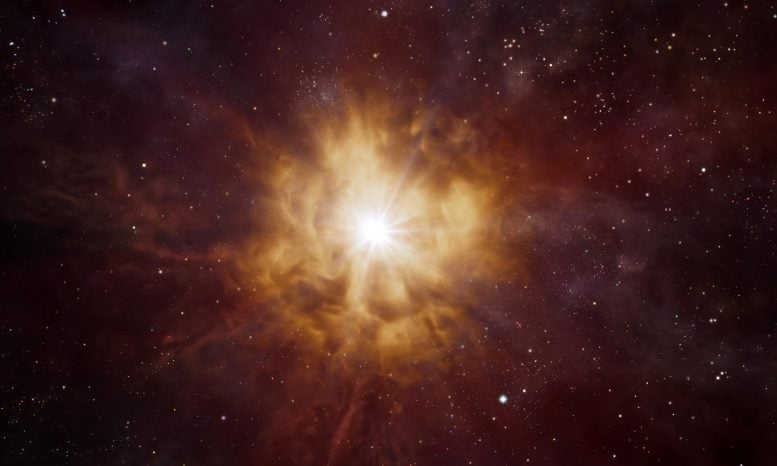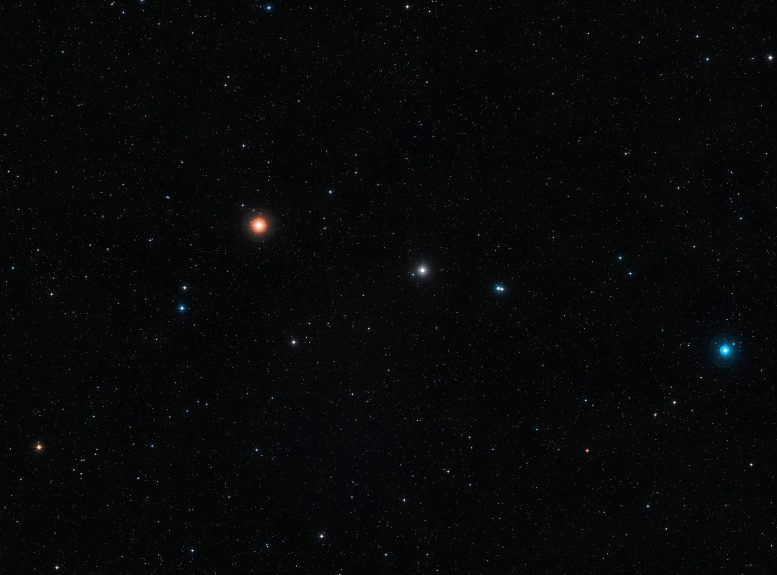This artist’s impression shows NGP–190387, a star-forming, dusty galaxy that is so far away its light has taken over 12 billion years to reach us. ALMA observations have revealed the presence of fluorine in the gas clouds of NGP–190387. To date, this is the most distant detection of the element in a star-forming galaxy, one that we see as it was only 1.4 billion years after the Big Bang — about 10% of the current age of the Universe. The discovery sheds a new light on how stars forge fluorine, suggesting short-lived stars known as Wolf–Rayet are its most likely birthplace. Credit: ESO/M. Kornmesser
A new discovery is shedding light on how fluorine — an element found in our bones and teeth as fluoride — is forged in the Universe. Using the Atacama Large Millimeter/submillimeter Array (
A new finding, made with the ALMA observatory, in which ESO is a partner, is shedding light on how fluorine is forged in the Universe. Find out more in this discovery, and how it is related to our dental hygiene, in this video summary. Credit: ESO
Franco and his collaborators spotted fluorine (in the form of hydrogen fluoride) in the large clouds of gas of the distant galaxy NGP–190387, which we see as it was when the Universe was only 1.4 billion years old, about 10% of its current age. Since stars expel the elements they form in their cores as they reach the end of their lives, this detection implies that the stars that created fluorine must have lived and died quickly.
The team believes that Wolf–Rayet stars, very massive stars that live only a few million years, a blink of the eye in the Universe’s history, are the most likely production sites of fluorine. They are needed to explain the amounts of hydrogen fluoride the team spotted, they say. Wolf–Rayet stars had been suggested as possible sources of cosmic fluorine before, but astronomers did not know until now how important they were in producing this element in the early Universe.

This artist’s impression shows the bright core of a Wolf–Rayet star surrounded by a nebula of material which has been expelled by the star itself. Wolf–Rayet stars are hot and massive with lifespans of a few million years. They are thought to end in dramatic supernova explosions, ejecting the elements forged in their cores into the cosmos. Credit: ESO/L. Calçada
“We have shown that Wolf–Rayet stars, which are among the most massive stars known and can explode violently as they reach the end of their lives, help us, in a way, to maintain good dental health!” jokes Franco.
Besides these stars, other scenarios for how fluorine is produced and expelled have been put forward in the past. An example includes pulsations of giant, evolved stars with masses up to few times that of our Sun, called asymptotic giant branch stars. But the team believes these scenarios, some of which take billions of years to occur, might not fully explain the amount of fluorine in NGP–190387.
This animation takes us on a journey to one of the Wolf–Rayet stars in NGP–190387, a galaxy so far away its light took over 12 billion years to reach us. The images at the start of the video are real astronomical observations, while the galaxy and its Wolf–Rayet star (too distant to be imaged clearly) are represented by means of artists’ animations. Wolf–Rayet stars are hot and massive, with lifespans of a few million years and are thought to end in dramatic supernova explosions. Recent ALMA observations have spotted fluorine in the gas clouds of NGP–190387, making it the most distant detection of this element in a star-forming galaxy. This result suggests short-lived Wolf–Rayet stars may form most of the fluorine in galaxies. Credit: ESO/L. Calçada/M. Kornmesser/Digitized Sky Survey 2/N. Risinger (skysurvey.org)
“For this galaxy, it took just tens or hundreds of millions of years to have fluorine levels comparable to those found in stars in the
This visible-light, wide-field image of the area of the sky where the remote galaxy NGP–190387 is found was created from images in the Digitized Sky Survey 2. The galaxy, located so far away its light took over 12 billion years to reach us, lies close to the center of the image. Although it is not visible in this picture, many other, much closer, galaxies can be seen in this wide-field view. Credit: ESO/Digitized Sky Survey 2, Acknowledgement: Davide De Martin
